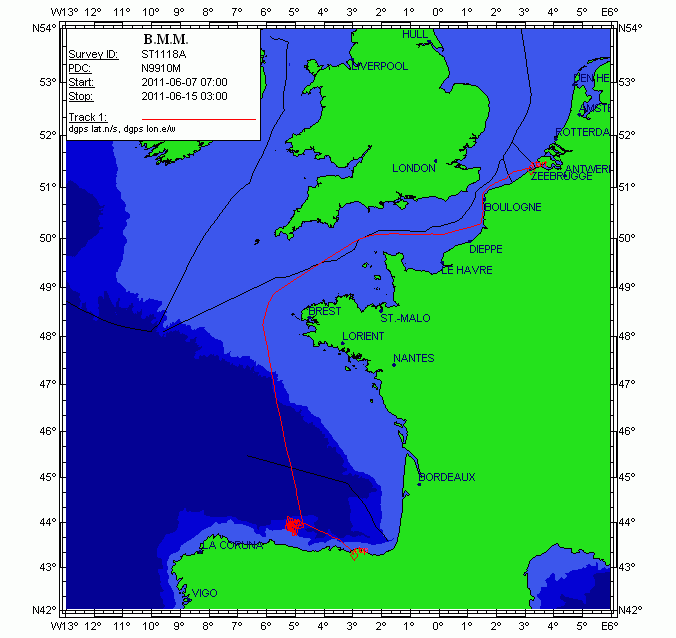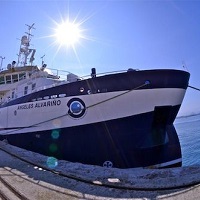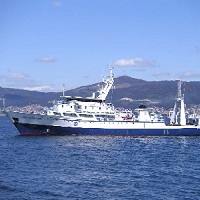Keyword
Cetacean behaviour
21 record(s)
Type of resources
Categories
Topics
INSPIRE themes
Keywords
Contact for the resource
Provided by
Years
Formats
Status
-

This cruise aims to investigate the seismic stratigraphy and palaeoceanographic evolution of the Le Danois contourite depositional system (Van Rooij et al., 2010), at several locations in the Le Danois "intraslope basin". Previous research (R/V Belgica in 2004, among others) has highlighted a significant correlation with the Cadiz CDS, suggesting a nearly simultaneous control by the Mediterranean Outflow Water since the Early Pliocene. As such, the Le Danois CDS is the only location in the Bay of Biscay where high-resolution climate change (e.g. bottom currents) may be recorded in a continuous way. It will assist in better constrain the role of the MOW in the thermohaline circulation system. Therefore, this large-scale sediment body is an ideal target for (a) investigating the MOW palaeoceanography within the NE Atlantic basin and (b) a palaeoclimatologic reconstruction of the Cantabrian margin. The main objective of this campaign is to acquire additional geophysical data which will give more insight in the construction and 3D evolution of this sedimentary deposit. This campaign will be executed in close cooperation with the Proyecto Coordinado CONTOURIBER (CTM 2008-06399-C04/MAR), with invited researchers from Spanish research institutes. More specifically, R/V Belgica ST1118a aims to perform: 1.High-resolution single channel sparker seismic profiling: investigation of the stratigraphic framework and the sedimentary environment in the western part of the intraslope basin between the Vizco High (west), the Lastras canyon system (east), Le Danois bank (north) and the Asturias slope (south). This will mainly focus on the lateral and temporal evolution of Le Danois drift and the Gijon drift and their interaction. The location of these profiles is determined based on industrial multichannel airgun profiles, in order to compare seismic methods with different penetration depths and seismic resolutions. We are very grateful to TGS-NOPEC for allowing us to use a large unpublished data set of seismic records from the Cantabrian Sea. 2.Hydrography: at specific sites in the intraslope basin, CTD casts will aim to better map the presence and behavior of the Mediterranean Outflow Water within the main elements of the Gijon and Le Danois drifts. The newly acquired Seapoint turbidity sensor will be able to indicate regions of active sediment transport within the Le Danois CDS. Multibeam bathymetry with the Belgica EM1002 will be only be used as a backup in case of spare time or failure of the other methods. The proponents are aware of the Marine Protected Area status of the Le Danois Bank, and will be vigilant to respect the guidelines of conducting scientific research. In order to ensure vigilance with respect to marine mammals, a team of whale watchers of MUMM, ULg (Belgium), CRMM (France) and OCEAMM (France) will be participating. This part of the campaign is a cooperation between the RCMG (UGent), the University of Vigo, the Geological Survey of Spain (IGME), the Spanish Oceanographic Institute (IEO), the Spanish Institute of Marine Sciences (CMIMA-CSIC) and the University of Cádiz.
-

- Estimate the abundance of cetaceans in oceanic and shelf waters of the European Atlantic in 2016. - These estimates will give the necessary information to evaluate the good environmentla status and the conservation status of the main species of cetaceans in the Atlantic. - In addition these estimates are needed to evaluate the impact of the different anthropogenic pressures on the populations of these species.
-

Cetaceans, Oceanography and biodiversity of the Deep Waters of El Hierro y La Palma islands
-

1. Calibration and testing transducers noise. 2. To estimate the abundance of the main pelagic fish (sardines, anchovies, mackerel, etc.) by the method of echo integration in the northern Spanish coast and map their range. 3. Determine the main biological characteristics of target fish species: age structure and length, length / weight ratio and maturity stage from sampling biological sardine, anchovy, mackerel, horse mackerel, horse mackerel, chub mackerel, blue whiting and hake. 4. Determine the size structure of all fish species caught. 5. Estimate the TS / length ratio of the target species 6. To estimate the relative abundance and mapped the distribution of sardine and anchovy eggs. 7. Characterization of the hydrological conditions of the survey area, especially thermohaline properties of the waters over the continental shelf. Measurement of vertical profiles of temperature, salinity and fluorescence in stations (CTD Casts) and acquisition of continuous sea surface data (ttemperature, salinity and fluorescence). 8. Study of the relationship of oceanographic and meteorological conditions with distribution and abundance of sardine eggs and adults. 9. Determine the distribution patterns of taxonomic diversity and biomass different size classes of plankton (pico-, phyto- and zooplankton) in the study area. 10. Characterize the horizontal and vertical distribution of plankton. Mapping biomass plankton size classes 11. Plankton biomass estimation, fractional and total. Studying the relationship between ichthyoplankton and plankton. 12. Estimate the natural abundance of N15 in sardine, anchovy, mackerel, and krill and myctophids to determine their trophic position. 13. Mapping the abundance of top predators 14. Map the relative abundance of anthropogenic sea surface microplastic 15. Estimate the strength of recruitment of anchovy and other species in the Cantabrian observed during the JUVENA campaign. 16. Estimate blue whiting biomass in Porcupine Seabight in coordination with the other nations performing the International Blue Whiting Spring Survey (IBWSS).
-

1. Calibration and testing transducers noise. 2. To estimate the abundance of the main pelagic fish (sardines, anchovies, mackerel, mackerel, etc.) by the method of echo integration in the northern Spanish coast and map their range. 3. Determine the main biological characteristics of target fish species: age structure and length, length / weight ratio and maturity stage from sampling biological sardine, anchovy, mackerel, horse mackerel, horse mackerel, chub mackerel, blue whiting and hake. 4. Determine the size structure of all fish species caught. 5. Estimate the TS / length ratio of the target species 6. To estimate the relative abundance and mapped the distribution of sardine and anchovy eggs. 7. Characterization of the hydrological conditions of the survey area, especially thermohaline properties of the waters over the continental shelf. Measurement of vertical profiles of temperature, salinity and fluorescence in stations (CTD Casts) and acquisition of continuous sea surface data (ttemperature, salinity and fluorescence). 8. Study of the relationship of oceanographic and meteorological conditions with distribution and abundance of sardine eggs and adults. 9. Determine the distribution patterns of taxonomic diversity and biomass different size classes of plankton (pico-, phyto- and zooplankton) in the study area. 10. Characterize the horizontal and vertical distribution of plankton. Mapping biomass plankton size classes 11. Plankton biomass estimation, fractional and total. Studying the relationship between ichthyoplankton and plankton. 12. Estimate the natural abundance of N15 in sardine, anchovy, mackerel, and krill and myctophids to determine their trophic position. 13. Mapping the abundance of top predators 14. Map the relative abundance of anthropogenic sea surface microplastic 15. Estimate the strength of recruitment of anchovy and other species in the Cantabrian observed during the JUVENA campaign.
-

1. Calibration and testing transducers noise. 2. To estimate the abundance of the main pelagic fish (sardines, anchovies, mackerel, etc.) by the method of echo integration in the northern Spanish coast and map their range. 3. Determine the main biological characteristics of target fish species: age structure and length, length / weight ratio and maturity stage from sampling biological sardine, anchovy, mackerel, horse mackerel, horse mackerel, chub mackerel, blue whiting and hake. 4. Determine the size structure of all fish species caught. 5. Estimate the TS / length ratio of the target species. 6. Characterization of the hydrological conditions of the survey area, especially thermohaline properties of the waters over the continental shelf. Measurement of vertical profiles of temperature, salinity and fluorescence in stations (CTD Casts) and acquisition of continuous sea surface data (ttemperature, salinity and fluorescence). 7. Study of the relationship of oceanographic and meteorological conditions with distribution and abundance of sardine eggs and adults. 8. Determine the distribution patterns of taxonomic diversity and biomass different size classes of plankton (pico-, phyto- and zooplankton) in the study area. 9. Characterize the horizontal and vertical distribution of plankton. Mapping biomass plankton size classes 10. Plankton biomass estimation, fractional and total. Studying the relationship between ichthyoplankton and plankton. 11. Estimate the natural abundance of N15 in sardine, anchovy, mackerel, and krill and myctophids to determine their trophic position. 12. Mapping the abundance of top predators 13. Map the relative abundance of anthropogenic sea surface microplastic 14. Estimate the strength of recruitment of anchovy and other species in the Cantabrian observed during the JUVENA campaign.
-

1. Calibration and testing transducers noise due to the change of their location. 2. To estimate the abundance of the main pelagic fish (sardines, anchovies, mackerel, mackerel, etc.) by the method of echo integration in the northern Spanish coast and map their range. 3. Determine the main biological characteristics of target fish species: age structure and length, length / weight ratio and maturity stage from sampling biological sardine, anchovy, mackerel, horse mackerel, horse mackerel, chub mackerel, blue whiting and hake. 4. Determine the size structure of all fish species caught. 5. Estimate the TS / length ratio of the target species 6. To estimate the relative abundance and mapped the distribution of sardine and anchovy eggs. 7. Characterization of the hydrological conditions of the survey area, especially thermohaline properties of the waters over the continental shelf. Measurement of vertical profiles of temperature, salinity and fluorescence in stations (CTD Casts) and acquisition of continuous sea surface data (ttemperature, salinity and fluorescence). 8. Study of the relationship of oceanographic and meteorological conditions with distribution and abundance of sardine eggs and adults. 9. Determine the distribution patterns of taxonomic diversity and biomass different size classes of plankton (pico-, phyto- and zooplankton) in the study area. 10. Characterize the horizontal and vertical distribution of plankton. Mapping biomass plankton size classes 11. Plankton biomass estimation, fractional and total. Studying the relationship between ichthyoplankton and plankton. 12. Estimate the natural abundance of N15 in sardine, anchovy, mackerel, and krill and myctophids to determine their trophic position. 13. Mapping the abundance of top predators 14. Map the relative abundance of anthropogenic sea surface microplastic 15. Estimate the strength of recruitment of anchovy and other species in the Cantabrian observed during the JUVENA campaign.
-

1. Calibration and testing transducers noise due to the change of their location. 2. To estimate the abundance of the main pelagic fish (sardines, anchovies, mackerel, mackerel, etc.) by the method of echo integration in the northern Spanish coast and map their range. 3. Determine the main biological characteristics of target fish species: age structure and length, length / weight ratio and maturity stage from sampling biological sardine, anchovy, mackerel, horse mackerel, horse mackerel, chub mackerel, blue whiting and hake. 4. Determine the size structure of all fish species caught. 5. Estimate the TS / length ratio of the target species 6. To estimate the relative abundance and mapped the distribution of sardine and anchovy eggs. 7. Characterization of the hydrological conditions of the survey area, especially thermohaline properties of the waters over the continental shelf. Measurement of vertical profiles of temperature, salinity and fluorescence in stations (CTD Casts) and acquisition of continuous sea surface data (ttemperature, salinity and fluorescence). 8. Study of the relationship of oceanographic and meteorological conditions with distribution and abundance of sardine eggs and adults. 9. Determine the distribution patterns of taxonomic diversity and biomass different size classes of plankton (pico-, phyto- and zooplankton) in the study area. 10. Characterize the horizontal and vertical distribution of plankton. Mapping biomass plankton size classes 11. Plankton biomass estimation, fractional and total. Studying the relationship between ichthyoplankton and plankton. 12. Estimate the natural abundance of N15 in sardine, anchovy, mackerel, and krill and myctophids to determine their trophic position. 13. Mapping the abundance of top predators 14. Map the relative abundance of anthropogenic sea surface microplastic 15. Estimate the strength of recruitment of anchovy and other species in the Cantabrian.
-

1. Calibration and testing transducers noise. 2. To estimate the abundance of the main pelagic fish (sardines, anchovies, mackerel, etc.) by the method of echo integration in the northern Spanish coast and map their range. 3. Determine the main biological characteristics of target fish species: age structure and length, length / weight ratio and maturity stage from sampling biological sardine, anchovy, mackerel, horse mackerel, horse mackerel, chub mackerel, blue whiting and hake. 4. Determine the size structure of all fish species caught. 5. Estimate the TS / length ratio of the target species 6. To estimate the relative abundance and mapped the distribution of sardine and anchovy eggs. 7. Characterization of the hydrological conditions of the survey area, especially thermohaline properties of the waters over the continental shelf. Measurement of vertical profiles of temperature, salinity and fluorescence in stations (CTD Casts) and acquisition of continuous sea surface data (ttemperature, salinity and fluorescence). 8. Study of the relationship of oceanographic and meteorological conditions with distribution and abundance of sardine eggs and adults. 9. Determine the distribution patterns of taxonomic diversity and biomass different size classes of plankton (pico-, phyto- and zooplankton) in the study area. 10. Characterize the horizontal and vertical distribution of plankton. Mapping biomass plankton size classes 11. Plankton biomass estimation, fractional and total. Studying the relationship between ichthyoplankton and plankton. 12. Estimate the natural abundance of N15 in sardine, anchovy, mackerel, and krill and myctophids to determine their trophic position. 13. Mapping the abundance of top predators 14. Map the relative abundance of anthropogenic sea surface microplastic 15. Estimate the strength of recruitment of anchovy and other species in the Cantabrian observed during the JUVENA campaign. 16. Estimate blue whiting biomass in Porcupine Seabight in coordination with the other nations performing the International Blue Whiting Spring Survey (IBWSS).
-

1. Calibration and testing transducers noise. 2. To estimate the abundance of the main pelagic fish (sardines, anchovies, mackerel, mackerel, etc.) by the method of echo integration in the northern Spanish coast and map their range. 3. Determine the main biological characteristics of target fish species: age structure and length, length / weight ratio and maturity stage from sampling biological sardine, anchovy, mackerel, horse mackerel, horse mackerel, chub mackerel, blue whiting and hake. 4. Determine the size structure of all fish species caught. 5. Estimate the TS / length ratio of the target species 6. To estimate the relative abundance and mapped the distribution of sardine and anchovy eggs. 7. Characterization of the hydrological conditions of the survey area, especially thermohaline properties of the waters over the continental shelf. Measurement of vertical profiles of temperature, salinity and fluorescence in stations (CTD Casts) and acquisition of continuous sea surface data (ttemperature, salinity and fluorescence). 8. Study of the relationship of oceanographic and meteorological conditions with distribution and abundance of sardine eggs and adults. 9. Determine the distribution patterns of taxonomic diversity and biomass different size classes of plankton (pico-, phyto- and zooplankton) in the study area. 10. Characterize the horizontal and vertical distribution of plankton. Mapping biomass plankton size classes 11. Plankton biomass estimation, fractional and total. Studying the relationship between ichthyoplankton and plankton. 12. Estimate the natural abundance of N15 in sardine, anchovy, mackerel, and krill and myctophids to determine their trophic position. 13. Mapping the abundance of top predators 14. Map the relative abundance of anthropogenic sea surface microplastic 15. Estimate the strength of recruitment of anchovy and other species in the Cantabrian observed during the JUVENA campaign.
 Catálogo de datos del IEO
Catálogo de datos del IEO